The California 5870A form is used to report the tax on accumulation distributions from trusts. It must be attached to the beneficiary's tax return for the taxable year in which the distribution is received. This form helps determine the tax liability associated with distributions that have accumulated over previous years.
Beneficiaries of trusts that receive accumulation distributions are required to file the California 5870A form. If a beneficiary has received distributions that include income accumulated in prior taxable years, they must report this using the form when filing their tax return.
To complete the California 5870A form, the following information is typically required:
-
Name and Social Security Number (SSN) or Individual Taxpayer Identification Number (ITIN) of the beneficiary.
-
Name and address of the trust.
-
Beneficiary's date of birth.
-
Details of the accumulation distributions received from the trust.
What are accumulation distributions?
Accumulation distributions refer to amounts that a trust has retained or accumulated over time rather than distributed to beneficiaries. These distributions may be subject to special tax rules, particularly if they relate to income that was not distributed during the years it was earned.
How is the tax calculated on accumulation distributions?
The tax on accumulation distributions is calculated based on the income accumulated in prior years. The form requires the beneficiary to report the amounts of current distributions, any tax-exempt interest, and other relevant details to compute the taxable portion. The form includes various sections to guide beneficiaries through the calculation process.
What happens if the income was accumulated for less than five taxable years?
If the income was accumulated for less than five taxable years, beneficiaries must complete a specific section of the California 5870A form that addresses this situation. The calculations differ slightly from those used for income accumulated over five years or more, focusing on the shorter accumulation period.
Failure to file the California 5870A form when required may result in penalties and interest on any unpaid taxes. It is important for beneficiaries to ensure compliance with tax filing requirements to avoid potential financial consequences.
The California 5870A form can be obtained from the California Franchise Tax Board's website or through various tax preparation software. It is advisable to use the most current version of the form to ensure accuracy in filing.
Yes, the California 5870A form can be filed electronically if the beneficiary is using tax preparation software that supports this form. Many taxpayers find electronic filing to be a convenient option, as it often allows for faster processing and confirmation of submission.
